Customer Churn is one of the most serious problems for many businesses, in which customer loyalty has a key influence on market success, and must be dealt with by organizations promptly.
The single most important thing in customer churn and retention is to understand the customers well enough: customers' demographic, geographic, psychographic aspects, their tendencies, expectations, satisfaction, etc. The best way to confront this challenge of churn is to develop an effective retention strategy.

Case Study: Survey based Data Analysis to detect Churn drivers and identify likely defectors to build smart retention strategies
Objective:
To understand customer churn, identify which customer group is more prone to churn and to help the company find the right path forward towards developing an effective retention strategy for this customer base.
Approach:
Survey: Current customers and defectors were surveyed with separate set of questions asked to the defectors than those to the existing customers. The survey was aimed to study churn both at short-term (during the next 3 months) and long-term (during the next 6 months). The questionnaire was primarily aimed to collect quantitative responses most suitable for statistical analysis.
Analysis: Once the data was collected it was coded and structured for further analysis. This was followed by a full scale analysis using churn analytics techniques.
- Churn Trend Analysis: Analyze trends in customer segments. With Sales Trend Analysis, customer segments with increasing churn trends were identified.
- Customer Churn Profiling: Develop profiles of churn risk groups based on demographic, geographic, psychographic attributes and service usage patterns.
- Customer Churn Scoring and Segmentation: Build forecasting models (or rule models) to predict likelihood of defection and perform segmentation based on defection scoring.
Summary Report: An incisive report was produced summarizing the findings from the survey with analysis along with actionable recommendations on retention strategies.

Outcome
The client was able to identify the types of churn which was divided into compulsory and voluntary. The customer was able to identify high risk customers who were most likely to churn as well as help them take early action to retain these customers. The analysis also revealed key customers with a high Life time value who could be targeted on priority with retention offers.
Customer Analytics : Customer Churn & Loyalty Analytics on Telecom Subscriber data
Market Equations developed a Customer Churn Analysis Scorecard solution for a large Telecom service provider in the United States to identify key churn drivers, identify subscribers who were most likely to abandon the service as well as to tag subscribers as "one time subscriber" or subscribers who have reached the "point of no return" and help them retain subscribers by implementing churn prevention strategies so that customer service could be focused on those subscribers who were most likely to continue the services. Read More


